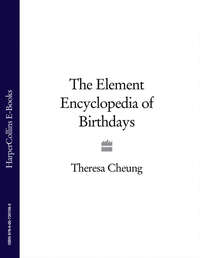![The Dream Dictionary from A to Z [Revised edition]: The Ultimate A–Z to Interpret the Secrets of Your Dreams](/covers_330/48653382.jpg)
Полная версия
The Dream Dictionary from A to Z [Revised edition]: The Ultimate A–Z to Interpret the Secrets of Your Dreams


COPYRIGHT
Thorsons
An imprint of HarperCollinsPublishers
1 London Bridge Street
London SE1 9GF
www.harpercollins.co.uk
Original edition first published as The Element Encyclopedia of 20,000 Dreams 2006
This revised and updated edition published by Thorsons 2019
© Theresa Cheung 2006, 2019
Cover design © HarperCollinsPublishers Ltd 2019
Cover illustrations © Kathleen Edwards and Shutterstock.com (stars)
A catalogue record of this book is available from the British Library
Theresa Cheung asserts the moral right to be identified as the author of this work
All rights reserved under International and Pan-American Copyright Conventions. By payment of the required fees, you have been granted the nonexclusive, non-transferable right to access and read the text of this e-book on screen. No part of this text may be reproduced, transmitted, downloaded, decompiled, reverse engineered, or stored in or introduced into any information storage retrieval system, in any form or by any means, whether electronic or mechanical, now known or hereinafter invented, without the express written permission of HarperCollins e-books.
Find out about HarperCollins and the environment at www.harpercollins.co.uk/green
Source ISBN: 9780008366476
Ebook Edition © November 2019 ISBN: 9780007484096
Version 2019-09-24
C ONTENTS
Cover
Title Page
Copyright
Welcome to a Whole New World of Dreams
Introduction: Prepare to Dream
A–Z Bedside Reader
A
B
C
D
E
F
G
H
I
J
K
L
M
N
O
P
Q
R
S
T
U
V
W
X Y Z
The 50 Most Common Dreams
10 Common Dreams You Should Never Ignore
Acknowledgments
About the Publisher
W ELCOME TO A WHOLE NEW WORLD OF DREAMS
I dream, therefore I exist.
– J. August Strindberg
Dreams are timeless, but books written about them aren’t. That’s why I’m delighted this Dream Dictionary has earned itself a reissue. The images that appear in our dreams are informed by enduring archetypes and symbols, but also by what is current and relevant to our lives today. Being given the opportunity to update the Introduction and endmatter, and add some additional entries, close to fifteen years after this book was first written, ensures its relevance. I hope this updated version will remain a classic bedside dream companion for many years to come.
Night Visions
We’ve all woken up from dreams that have felt incredibly real, as if what we experienced actually happened, but then we wake up and can’t make any sense of whatever it was that we felt and saw. We wonder what it all meant.
The majority of dream researchers today believe that dreams are not random and meaningless but rich in messages from our unconscious. They are inner communications that, if we know how to interpret them, can be powerful tools for personal growth. Sadly, many of us forget our dreams when we wake up, and this is a great loss. According to the Talmud: ‘A dream which is not interpreted is like a letter which is not read.’
If you are to recall, understand, and work with your dreams, you first need to learn how to make sense of them. This Dream Dictionary is an illuminating guide to the most common symbols that are likely to appear in your dreamscape, a rich resource to help you unlock the wisdom of your night visions. Use it to find out what your dreams are trying to tell you. But before you submerge yourself in the intoxicating world of your dreams, take a moment to find out how you can make the very best use of this book.
How to Use This Book
This Dream Dictionary is arranged in three parts: the Introduction, the A to Z Bedside Reader, and a closing section dedicated to the Most Common Dreams, or dreams you are almost certain to have at some point in your life.
The Introduction has been updated to take account of the latest research into the hows, whys and whats of sleep. It explores the complexities of dream interpretation and what you need to know about unlocking the meaning of your dreams. Although the dominant theme is that dreams have a symbolic and psychological interpretation, there’s also information about precognitive dreaming here, and whether it is actually possible to see the future in your dreams. And if you struggle to remember your dreams, or simply want to have a more active dream life, you will gain a great deal from the advice offered in the dream recall section.
You are strongly advised to read the Introduction before using the A to Z Reader to look up relevant dream entries as the advice in the Introduction will inform and enrich what you discover in the Reader. Be sure to check out the Most Common Dreams section at the end of the book too – preferably before you start using the A to Z Reader. Knowing how to interpret these very common dreams will get you thinking along the right lines and help you interpret all your other dreams. There is also advice about the kinds of dreams you would be wise not to ignore.
The A to Z Bedside Reader is the main body of the book. It’s been lightly updated to include a few new symbols, such as SOCIAL MEDIA, which we are more likely to dream about today than when the Dream Dictionary was originally written. Dream messages can be difficult to decipher until you have learned their secret language, and this section will give you keys to the wealth of creativity and insight stored in your dreaming mind. Understanding what your dreams are trying to tell you can help you transform and grow as a person. Your dreams reveal your deepest emotional and spiritual needs and allow you to experiment with an endless range of emotions, situations, and scenarios in a completely safe way. Only dreams can offer you such excitement, education, and enlightenment.
The entries in the A to Z Reader are arranged alphabetically for ease of use, but be aware that some entries, like dog, for example, are placed in categories, in this instance PETS. You will also find cross-references in many entries to other entries that might be helpful. Common dream symbols are listed as well as classic dream themes, such as FLYING or FALLING, but there are, of course, limitations in the number of entries this book can offer you; dreams invite a world of infinite possibilities and there simply isn’t a book vast enough to contain them all. If you do want a larger resource, thousands more entries can be found in my earlier dream title, The Element Encylopedia of 20,000 Dreams. You are also welcome to contact me about your dreams and how best to interpret them.
How to Contact the Author
You can message me via my reader email – angeltalk710@aol.com – or via my Facebook and Instagram Theresa Cheung author pages. You can also contact me via my website: www.theresacheung.com. Please do subscribe to my email if you visit my website. It’s a way for me to share the latest dream research, reader stories, and interpretation advice.
Feel free to get in touch to discuss your dreams or if you have questions, unusual or supernormal stories, or insights you want to share with me and potentially with a wider audience. I endeavor to reply to everyone who reaches out to me. Please bear in mind that sometimes it can take a while for me to reply if things are super-busy, or if I need to take a little time out to do some dreaming of my own.
And now, without further ado, welcome to the wonderful world of your dreams!
I NTRODUCTION: PREPARE TO DREAM
Once upon a time, I dreamt I was a butterfly, fluttering hither and thither, to all intents and purposes a butterfly. I was conscious only of my happiness as a butterfly, unaware that I was myself. Soon I awakened, and there I was, veritably myself again. Now I do not know whether I was then a man dreaming I was a butterfly, or whether I am now a butterfly dreaming I am a man.
– Chuang-Tzu
Every morning when you wake up and don’t recall any of your dreams – or dismiss the fleeting and surreal images that do surface in your mind as random nonsense – you miss an incredible opportunity for self-development. Hopefully, this book will help make dream amnesia a thing of the past and encourage you to treasure every one of your dreams as something sacred.
Treating dreams as sacred comes naturally to the Malaysian Senoi, a tribe noted by researchers for being completely free of depression and crime. The Senoi are believed to be such a happy and peaceful tribe because they use their dreams as tools for personal growth. From an early age Senoi children are encouraged to pay less attention to what is visible – the material world – and more to what is unseen – the world of the dream. Recording and discussing their dreams and using the insight of their night visions to guide their choices in waking life takes precedence over everything else.
The Senoi may be pointing us all in the right direction here. Many of us simply don’t pay enough attention to our dreams and miss out on a wealth of untapped wisdom. Research has shown that the more you recall and investigate your dreams, the better your creativity and problem-solving skills. Dreams may initially disorientate your logical mind because they typically don’t make any sense, but if you know how to interpret them even the oddest dreams can offer you priceless insights into your waking life. When analyzed effectively they are an incredibly rich source of guidance and healing, as well as the ideal catalysts for positive change and personal growth.
Why Do We Sleep?
Sleep is the balm for hurt minds, nature’s great second course.
– William Shakespeare
To better understand the nocturnal adventures of your mind it helps to know a little about the place where they all happen – the world of sleep. It is during sleep that we abandon conscious control over our body and mind and the unconscious or dreaming mind is allowed to roam free, giving rise to dreams.
We know that sleep is essential for our well-being but, like dreams, sleep remains a tantalizing mystery. It may surprise you to know that, to date, sleep researchers have not yet discovered the exact reason for sleep. For centuries it was thought that we needed to sleep to rest the body and mind, but this was disproved in the 1920s with the first electronic monitoring of the brain.
The brain gives off electrical impulses, and by attaching electrodes to various parts of the head scientists measure brain waves in a process known as electroencephalography. What these brain-wave readings (or ECGs) show is that both the body and the mind are active during sleep. So, if sleep doesn’t rest either your body or your mind, what is it for?
We don’t yet know for sure, but sleep researchers have uncovered some very intriguing things. It seems that when we fall asleep our brains act a little like computers that are offline. This means they are not idle but filing and updating. They do a system check on your body and release hormones to repair damaged tissues, stimulate growth, and fight infections. Sleep is therefore vital for the smooth running of many functions of your body and your brain, including memory, problem solving, and attention. Lack of sleep can lead to dementia, high blood pressure, heart disease, cancer, premature aging, weight gain, and lowered immunity. In short, sleep is essential, and we spend up to a third of our lives doing it. But despite all this we still aren’t entirely sure why we need it, and most doctors still don’t pay enough attention to the obvious importance of sleep for our physical and mental health.
However, the advent of space travel – of all things – has taught us a little more about sleep and why we need it. Scientists found that the prolonged periods of isolation and lack of external stimulation experienced by astronauts dramatically decreased their need for sleep. There is a sleep control center in our brains and when that gets overloaded with external stimuli we get tired. This explains why sometimes you nod off for no reason. Sleep is so crucial that your brain decides you have had quite enough stimulation and it’s time for you to switch off and recharge. If, however, there has not been enough stimuli from the outside world the sleep mechanism isn’t triggered, and you remain wide awake.
In other words, boredom, loneliness, routine, and the resulting lack of stimulation may account for episodes of insomnia. Although, paradoxically, it is worth noting that overstimulation has also been shown to trigger insomnia. Once again, whenever we edge closer to explaining the whats and whys of sleep, the plot thickens and the mystery remains.
The Stages of Sleep
Yet it is in our idleness, in our dreams, that the submerged truth sometimes comes to the top.
– Virginia Woolf
Perhaps the best way to learn more about sleep and why we need it is to understand what happens to our brains when we fall asleep.
Sleep researchers believe there are at least four stages of sleep, starting from when you begin to doze to when you lose conscious awareness and transform from a waking into a sleeping state. These stages are cyclic and repeat up to four or five times for every eight hours of sleep, each cycle lasting around 90 to 120 minutes. Here’s a brief, and by necessity, simplistic description of what typically happens when you go to bed at night.
During the first stage of sleep, when you lie down and close your eyes your body and mind relax. Heart and breathing rates slow down, blood pressure lowers, temperature drops, eyelids grow heavy, and eyes roll from side to side. During this stage you are semi-conscious and can easily awake. When people are sitting or traveling and they start to doze off, they struggle to keep their heads upright. This is stage one. It’s often called the hypnagogic state (the hypnopompic state is when you are just waking up) and it’s when you are most likely to experience hallucinations that float before your eyes.
In stage two, breathing and heart rate slow even further, eyes continue to roll, and you become more and more unaware of external stimuli or the noises from the outside world. It isn’t until the third and fourth stages of sleep, though, that you are finally sound asleep and it is harder to wake you up. You are now in a deep sleep state known as non-rapid eye movement (NREM) sleep.
In NREM sleep your brain is released from the demands of your conscious brain and it is rather difficult to wake you. This slow brain-wave sleep cycle typically lasts around 90 minutes. At the end of stage four you move back through stages three, two and one, at which point you enter a fifth stage of sleep called rapid eye movement or REM sleep. This is when things start to get really interesting and the dreams begin.
REM Sleep
One of the most adventurous things left us is to go to bed. For no one can lay a hand on our dreams.
– E. V. Lucas
REM sleep is defined by tiny twitches of facial muscles and slight movements of the hands. Blood pressure rises, breathing and heart rate become faster, the brain is fully active and eyes dart rapidly under closed eyelids as if you were looking at a moving object. If you are a man you may have an erection.
Although dreams can occur during NREM, researchers have discovered that it is REM sleep which is most associated with dreaming. When sleepers are awakened during REM sleep, they typically recall their dreams. Sometimes people feel temporarily paralyzed if woken during REM, as if something heavy and/or malevolent is pressing down on them. This phenomenon may explain supposed succubus, incubus, and alien abduction experiences.
The first stage of REM sleep lasts around 10 minutes and then you fall back into stages two, three and NREM sleep again, and keep moving backwards and forwards between the stages through the sleep cycle. As the cycle continues, however, the REM phase gets longer and longer, with the longest phase lasting up to 45 minutes. Of all the phases of REM and NREM sleep, the final REM phases are the ones from which you are most likely to recall your dreams.
The emotional center of the brain is more active than the logical center when we are dreaming. But, intriguingly, scientists have found that dreaming about faces is linked to the areas of the brain involved in facial recognition when we are awake, suggesting that the dreaming and waking brain may not be as different as is often thought.
We Sleep to Dream
And one day there will come a great awakening when we shall realize that life itself was a great dream.
– Chuang-Tzu
Experiments have proved that sleep is essential for life. Rats typically live for two to three years; rats deprived of all stages of sleep live for about three weeks, and rats deprived of only REM sleep survive for about five. Other research has shown that both NREM and REM sleep are essential for preserving memory, but if people are repeatedly woken during periods of REM sleep – which means they are deprived of their dreamtime – they become anxious, irritable and stressed. This suggests that all stages of sleep are vital for physical and mental health, and REM sleep – when you are most likely to dream – is essential for your emotional and psychological well-being.
Therefore, although we still don’t know why we sleep, it is entirely possible that one of the major reasons we sleep is to dream.
How Much Sleep Do We Need?
We spend up to a third of our lives sleeping, which means that if you reach the age of 100 you will have been asleep for around 33 years. The amount of sleep each person needs to feel healthy and think clearly depends on many factors, including age and activity levels. For example, babies need around 14–15 hours a day, while teenagers need around 9–10 hours. For most moderately active adults around 7–8 hours of sleep a night appears to be the average amount needed, although some people need as few as 5 hours and others need up to 10. Elderly people tend to need a little less sleep, around 6–7 hours a night, and women tend to need more sleep than men. Women also tend to be lighter sleepers and more likely to wake during the night than men.
So, What Are Dreams?
Life is a dream, realize it.
– Sathya Sai Baba
Dreams captivate us. But what are they? Where do they come from? Why do we have them? Do they mean anything? Are they simply a collection of memories and random associations, or insightful gifts from our intuition? Can they help us make decisions in our waking lives?
We have learned a great deal about dreaming – and, as mentioned previously, all the indications are that dreams are crucial for your mental and emotional health – but there is still so much we don’t know: dreams remain as mysterious as ever. This elusiveness hasn’t stopped people theorizing about why we have them.
There is a school of thought which believes that dreams are meaningless, or just random neuron activity responding to biochemical changes. Others believe dreams are simply your brain’s way of decluttering or sorting out and consolidating memories and associations. However, most modern psychologists, scientists, and sleep researchers believe dreams are far more than that.
One prominent theory is that dreams reveal hidden insights, wishes, and truths about the dreamer. The world of the dream is a dramatization of the dreamer’s personal or inner world. Another popular theory suggests dreams can help you process or come to terms with difficult emotions to achieve psychological or emotional balance. Dreams may also help you rehearse, practice, and prepare different responses to situations or scenarios, in other words, they allow you to role play in a safe way.
There is also the popular ‘sleep on it’ view that dreams are a source of creative inspiration and can help with problem solving. One less prominent theory, but which has its supporters, is that dreams are a form of consciousness that can unite past, present and future and offer us glimpses of potential futures.
One thing that unites all these different theories is the belief that, whatever dreams are, they are good for you. They help you live a better, happier, life.
A Brief History of Dream Interpretation
Now Allah has created the dream not only as a means of guidance and instruction, I refer to the dream, but he has made it a window on the world of the unseen.
– The Prophet Mohammed
The notion that dreaming is positive, and dream interpretation a powerful tool, dates back millennia. Ancient art and literature are rich in dream references. Back in the mists of time dreams were not so much regarded as tools for personal growth (as they are today) but believed to have supernatural or prophetic significance. For example, the ancient Greeks, Romans, and Egyptians all believed dreams had miraculous healing powers, and the Bible promotes the idea that dreams are divine messages.
Other cultures, such as the Australian Aborigines and many African and Native American tribes, have always believed that dreams are a way to enter an unseen spirit realm. To this day, dream interpretation plays a major part in these tribal societies. The Inuit of Canada believe that when a person dreams, their soul leaves their body and enters the spirit realm.
As far as dream interpretation is concerned the Egyptians are thought to be the pioneers, producing the earliest known dream dictionary, written over 4,000 years ago. Called the Chester Beatty Papyrus today, it came from Thebes in Egypt and is kept in the British Museum. It is the ancient Greeks, however, who first proposed the theory that dreams are not from some external or divine source but are internal communications, or the divine spark within. Plato (427–347 BC) suggested that dreams were representations of hidden wishes and desires, while his pupil Aristotle (384–322 BC) suggested that dreams shared collective or similar themes. It was the ‘father of medicine’ Hippocrates (460–377 BC) who presented the idea that dream symbols had a physiological interpretation – for example, fire denoted indigestion – and should be used as diagnostic tools.
Artemidorus (AD 138–180), a Roman living in Greek Asia Minor, is believed to be the first dream researcher to focus fully on dream symbols and themes. He wrote a book entitled Oneirocritica (The Interpretation of Dreams) that is still in print today. He postulated that dream symbols had certain meanings but that the most important aspect of dream interpretation was the personal significance of the dream symbol to the dreamer. (This author is in total agreement with Artemidorus about the personal significance of dreams and their meaning, and can only dream that this dictionary stays in print as long as his remarkable manuscript!)









